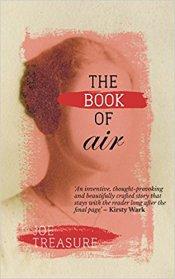
All the Elements: A Spring Reads book review of The Book of Air, a novel by Joe Treasure
The Book of Air by Joe Treasure is an exceptionally fine novel that discloses its secrets gradually, in triumphantly unexpected ways. The stories it tells gather momentum and significance with each short chapter; it is populated by personages in whom we can believe; it is profoundly intelligent and deeply engrossing. Its allusions and references are delightfully subtle and oblique, conveyed effortlessly by the author’s gift for language and ideas. I doubt I shall read a finer novel this year.
The Book of Air presents the reviewer with an impossible dilemma: how to talk about it without giving the game away. By ‘game’ I don’t mean mere plot spoilers – The Book of Air is a novel that positively requires to be read and reread. Rather, the pleasures the novel provides are so intricately bound up as parts to a whole that any choice of things to highlight risks exposing the entire enterprise. So I shall have to talk about The Book of Air by carefully avoiding talking about it.
Joe Treasure has the great gift of making the reader feel intelligent. When realizations dawn as to what exactly is going on, when small epiphanies and powerful revelations are grasped in all their ramifications, it’s hard not to be gratified, intrigued and somehow enhanced. This is particularly impressive if, like me, you are not drawn to speculative fiction, or your heart sinks at the sight of a novel that switches between two different stories chapter by chapter. In lesser hands, this latter aspect is so often a gimmick packed with forced associations and overly neat plot devices. In The Book of Air it is redeemed as an intensely literary and naturally expressive structure, entirely unforced and beautifully vindicated.
The Book of Air is about ending and beginnings, the past and the future:
‘…the world’s about to end all over again. There’s no end to the ending of things. Our life is one long sickening plummet into loss and more loss.’
I used to think of myself as walking forward into the future, constructing the future I was walking into. I used to think of myself as not wasting energy thinking of myself as one thing or another, but just doing what had to be done. Now I seem to stand sideways on, watching some version of me that isn’t quite me. I notice myself feeling things. Or not. Or more than one thing at a time.
It is a gothic novel inasmuch as it is centred chiefly on a single location – a large country house that has endured as uniquely itself yet is always in transition, in need of rescue.
Either we pay attention, or we abandon the place to the slow invasion of nature, the seep and drip of water finding the weak points, until a dozen winters have split it open like a fallen trunk for woodlice to crawl through and rodents and nesting birds … The heat’s off, the damp’s rising. The works of man are rotting from the inside.
Its inhabitants – pre- and post-apocalypse – are unwittingly associated across time. Thematically, this association is the most important aspect of the novel and its principal concern: how, why and in what forms a culture (especially literary culture) is transmitted, interpreted and fragmented, used and misused, twisted and distorted, lost and found, particularly after immense social upheaval. Why has humanity always needed to tell itself stories? Here is one answer, perhaps the only answer:
‘Maybe because it’s our deepest instinct – to make meaning.’
‘Even when there is no meaning?’
‘Especially then.’
The Book of Air is thus of necessity intertextual, and one of its pleasures is to identify its many instances. Byron, the Brontës, the Bible, George Eliot, Hardy, Hemingway, Austen, Conrad, Lawrence, Rhys – these are the few I identified, but there are surely many more. Try as I might, I cannot resist quoting one of the references to another cultural phenomenon: ‘In all the empty houses in all the towns in all the world she had to squat in mine.’ And it’s oddly typical how external coincidence plays into a novel of this kind: two days prior to reading The Book of Air, a film I was watching quoted from Margaret Wise Brown’s Goodnight Moon (1947), which is also referenced in the novel. It felt to me as if the book was reaching out and claiming my experience for its own.
The gothic frequently encompasses gender power relations: how men seek to exploit, control and confine women, and the mental and emotional consequences of oppression. In The Book of Air Agnes speaks from within the prison of her room: ‘This room is memory and I am lost in it … This room is mad and I am its only thought.’ Shades of The Yellow Wallpaper haunt her words.
Illegitimate claims to authority and righteous resistance to its demands reflect forward and back between the two stories of The Book of Air. The will to power – usually subconscious in its causation and explicitly provided with a religious justification – manifests itself over and over again by means of words in a book. Things change in order to stay the same, as Jason realizes:
I wanted to ask her – hadn’t she been here before? They give you a book. They say, it’s all in here, this is all you need.
The discovery that there is more than one book, that each has a story to tell, that we each have our own books, is The Book of Air’s liberating riposte to such dangerous nonsense, the outworkings of which are described in its moving finale.
As some of the extracts above indicate, the dialog is natural and unforced. There is a great deal of it, but it never feels excessive and it always reveals character in precise, unmistakable ways.
There are occasional typos and, towards the end of the novel, someone should have known the difference between leaks and leeks. These irritations aside, The Book of Air is a major achievement: compelling, surprising, true. A book that must surely endure.
Clink Street Publishing | ISBN 9781911525097 (pbk) | ISBN 9781911525103 (ebook)
Click to Buy
